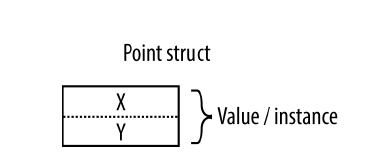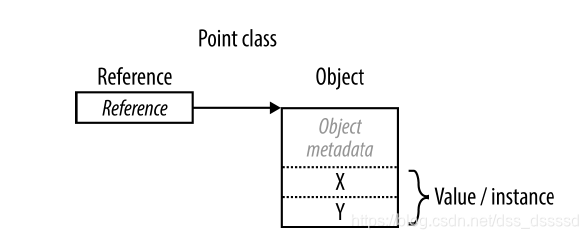值类型和引用类型(Value Types Versus Reference Types)
上一篇对于type的定义其实不准确,在此给出更准确的定义。
所有的C#类型包括:
- Value types
- Reference types
- Generic type parameters
- Pointer types
先看一下值类型和引用类型,其余的之后再看
- 值类型: 内建的 all
numerictypes, thechartype, and thebooltype和自定义的struct和enum类型 - 引用类型:class, array, delegate, and interface types 和内建的string type
两者的基本不同是在内存中的处理方式不同
-
Value types
值类型的变量或常量仅仅是一个值,比如内建整型int的变量仅仅是一个32位的数据public struct Point { public int X, Y; }
对于值类型而言,实例赋值直接深拷贝一份,即创建另一份内存
static void Main()
{
Point p1 = new Point();
p1.X = 7;
Point p2 = p1; // Assignment causes copy
Console.WriteLine (p1.X); // 7
Console.WriteLine (p2.X); // 7
p1.X = 9; // Change p1.X
Console.WriteLine (p1.X); // 9
Console.WriteLine (p2.X); // 7
}

- 引用类型
引用类型包含两部分: 对象和对象的引用。而引用类型的实例对象是包含值得对象的引用。简单的就是一个指向内存的指针,指向的内存中包含值。和C++的指针一样


Null: 引用可以赋值为null, 表示没有指向任何对象
class Point {...}
...
Point p = null;
Console.WriteLine (p == null); // True
// The following line generates a runtime error
// (a NullReferenceException is thrown):
Console.WriteLine (p.X);
而值不可以赋值为null
struct Point {...}
...
Point p = null; // Compile-time error
int x = null; // Compile-time error
内存占用(Storage overhead)
- 值类型实例精确地占用了存储字段所需的内存
下面的Point占用8个字节
struct Point
{
int x; // 4 bytes
int y; // 4 bytes
}
而引用类型需要为对象和引用(指针)分配内存,需要的内存更大
-
位操作符:

-
条件操作符
|| && != ==
res = q ?a : b => if q{ res= a} else{res=b}




















 663
663











 被折叠的 条评论
为什么被折叠?
被折叠的 条评论
为什么被折叠?








